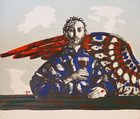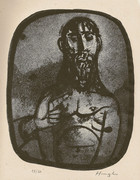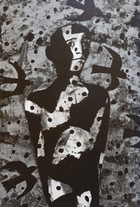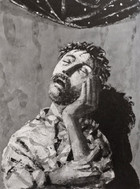Max Hunziker
(1907-1976)
Switzerland can claim two internationally-renowned names in modern art: Sculptor Alberto Giacometti and Painter Paul Klee. Giacometti’s haunting stick figures evoke universal spiritual themes, and Klee created a whole series of angel images in the year before his death in 1940. To find a contemporary Swiss artist, who consistently turned to the Judeo-Christian tradition for inspiration, we must look to Max Hunziker. Better known in the German-speaking world, this multi-faceted creator of paintings, prints, book illustrations, and stained glass explored biblical themes in contemporary, at times, enigmatic ways throughout his career.
The son of a milkman, Hunziker was born, lived, worked, and died in Zurich. As the youngest of twelve children, he was given the chance to receive a formal education and studied to be a school teacher, before deciding to take up art. In 1920, Hunziker traveled to Florence and spent five years in Italy, absorbing its rich legacy of sacred imagery. With support from Swiss Art Collector and Philanthropist Georg Reinhart, he continued his art education in Paris and Southern France from 1926 until 1939. Hunziker was especially drawn to the stained glass windows of the cathedrals in Paris, Chartres, Bourges, and Le Mans. He considered two modern French masters to be his mentors: Paul Cezanne and George Rouault.
On the eve of World War II, Hunziker returned to his homeland, where he devoted himself to printmaking, experimenting with direct relief etching. He would begin by painting a reversed design on a zinc or copper plate with asphalt lacquer, going on to create tonal effects with a burin, wire brushes, or cotton wool soaked in alcohol before dipping the plate in an acid bath. This etching method allowed book publishers to print original illustrations at a reasonable cost. Hunziker is particularly noted for the 169 direct relief etchings he created for the 1945 Zurich edition of Simplicius Simplicissimus, a classic 17th century German picaresque novel set during the Thirty Years' War. His etchings include images of the hand of God, angels and demons, the rite of baptism, and other sacred motifs.
The Swiss artist was an innovator in stained glass art, using lighter-than-glass materials like polystyrene to develop more flexible designs in a broader range of colors than was possible with traditional glass-making methods. He created eleven windows on the theme of the Lord’s Prayer for the Reformed Church of Volketswil, Switzerland, and three windows combining Old and New Testament themes for the choir of the Johanneskirche in the capital of Berne.
Hunziker has been described as a “Christian Surrealist.” He juxtaposes figures and objects in intriguing ways on flat planes of pure color, reducing to them to their essential forms and investing them with symbolic meaning. Hunziker developed his own iconography. A detached angel wing appears in three images on display here: a lithograph of Adam and Eve, a lithograph of a Eucharistic scene, and a grisaille illustration of King David for an edition of the Psalter. In two other prints, wound-like markings resembling stigmata suggest sin and suffering. Hunziker often used a generalized portrait of a young, bearded figure, the prototypical Everyman who resembles--and becomes--the image of Christ.

The Annunciation

Guardian Angel

Home Prayers

Adam and Eve

Holy Honeycomb

The Shepherd

The Black Sheep

The Eucharist

Christmas Eve

Simplicissimus: Book I, Chapter One, p. 20

Simplicissimus: Book II, Chapter Twenty-Four, p. 133

Simplicissimus: Book III, Chapter Three, p. 161

Simplicissimus: Book IV, Chapter Seven, p. 230

Simplicissimus: Book VI, Chapter Eighteen, p. 385

Der Psalter: Cover

Der Psalter: 11, p. 18.

Der Psalter, 69, p. 106.

Der Psalter, 81, p. 132.

